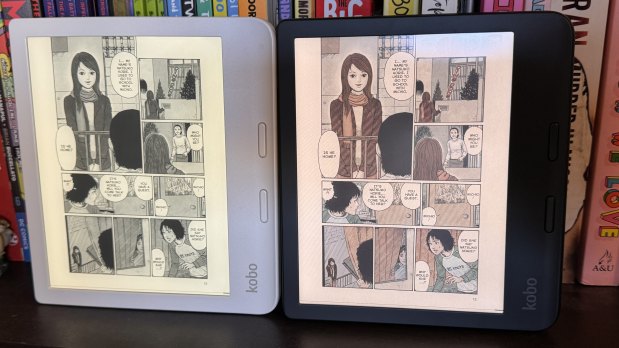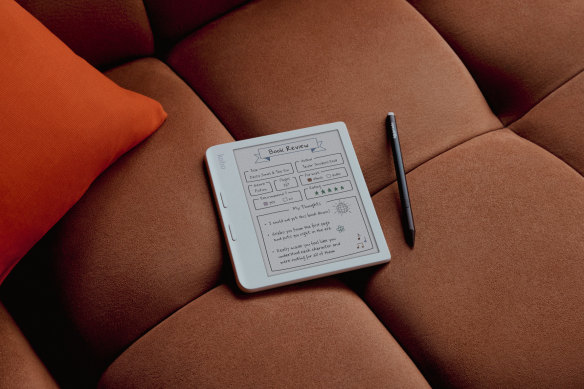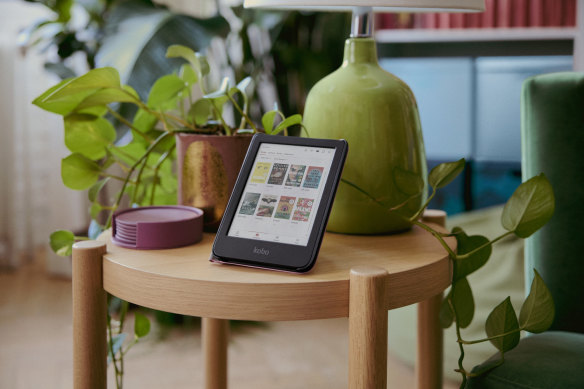- Review
- Technology
- Gadgets
This was published 3 months ago
It’s not black and white: New e-reader brings more colour, but less clarity
By Tim Biggs
Canadian e-book maker Kobo has revealed an unexpected new weapon in its ongoing war against Amazon’s Kindle: a line of devices with colour E-ink screens.
Suddenly, covers pop with various hues in the bookstore, while digital magazines, comics and guides are all displayed as intended rather than in greyscale. And all with the same low glare, low power, paper-like experience that makes e-readers so much nicer to read than phones or tablets.
The $360 Libra Colour is also the least expensive Kobo to be compatible with the company’s stylus, which enables you to highlight passages, keep notes and turn your handwriting into digital text – an experience also much improved by colour.
However, when you compare it directly to the black-and-white model, it becomes apparent that the colour screen comes with some compromises. So, if you’re predominantly reading regular monochrome books, the new product isn’t necessarily a recommended upgrade.
No longer black and white
It’s hard to overstate how big a difference it makes to the look of your virtual bookshelf or the Kobo store when it’s all rendered in colour. It’s not exactly like a tablet or phone because the limited palette means everything has a slightly washed pastel look to it. However, each title stands vividly apart.
Opening a new book to see a full-screen colour cover is really cool, and since the e-reader shows the cover of your current book when it’s turned off, the colour screen also makes it a more interesting object when it’s just sitting around.
But once I started reading a book, the first thing I noticed was that the white background part of the screen is not creamy and paper-like, as with other high-end e-readers; it’s a fine lattice texture made up of tiny dots that create a sort of rainbow pattern as they catch the light. To me, it looked like an LCD screen that had been accidentally sprayed with water.
Of course, directly after that, I became absorbed in the book and stopped noticing the texture, but it is a distracting element that monochrome readers don’t have.
Comparing the Libra Colour to the $320 Libra 2, it’s also obvious the new model has inferior contrast; the text is essentially black on the Libra 2, but it’s grey on the Colour. These two issues combined mean that when the screen is displaying nothing but type or monochrome images, it looks good on the Libra Colour but much nicer on the less expensive Libra 2.
The colour screen’s advantage, besides nicer covers and the fact that you can mark passages with four different highlighters instead of just one, is that it makes new kinds of material suitable for your e-reader. Things like storybooks, comic strips, magazines, cookbooks and travel guides are significantly more effective in colour than in black and white.
You could even load up on visual encyclopedias or digital versions of coffee table books, though big full-page layouts obviously aren’t as impressive when they’re barely 10 centimetres across.

For many books that aren’t purely text-based, the colour screen can add a lot.Credit: Tim Biggs
Something else I noticed was that any time a colour element is on-screen, the device’s resolution seems significantly reduced. For full-screen images, this is fine, but on a page with a blend of images and words, you end up with slightly less sharp text. Once again, in a direct comparison, you get cleaner (but monochrome) images on a black-and-white device.
Your own personal library or a public one
Screen aside, the Libra Colour is an upgraded version of the Libra 2, which is a fantastic e-reader.
Both products are waterproof and have backlights with adjustable brightness and colour – so you can read in any environment and limit blue light before bed – and are simple to use, with both touchscreens and page-turn buttons. However, the Libra Colour also includes the stylus compatibility of the $460 Libra Sage.

Paired with a Kobo stylus, the Libra Colour can act as a digital notebook.
With a sold-separately stylus, you can write directly onto your books to mark them up, handwrite notes to accompany your highlighted passages, or start your own notebooks from scratch.
For each notebook, you can choose from a range of templates (lined, dotted, margins and so on) or make an “advanced” notebook that converts your handwriting to typed text and formats, such as a word processor, so you can send documents back and forth to your PC.
As a notebook, the Libra Colour feels a little small, but the ability to switch pen and highlighter colours makes for much more attractive planning or revising.
The one thing that most separates Kobos from Kindles is their ability to source books from more places, and this remains true for the Libra Colour.
You can buy e-books directly from the on-device store or sign up to Kobo Plus for $14 per month to gain access to a catalogue of more than a million books.
If you have a PDF or unprotected e-book file you want to read, you can plug the Kobo into your PC and transfer it over or sync it via the cloud with Dropbox or Google Drive. For protected files you bought from a bookstore, you can transfer them using Adobe Editions. To send online articles to your Kobo, you can use Pocket.

Kobo is also introducing a colour version of its entry-level Clara e-reader.
The best part, though, is Overdrive, which lets you connect to public libraries. All you have to do is sign up for a borrowing card at a library that uses Overdrive, then plug your card number into the Kobo. Now, you can search, browse, borrow and read your library’s e-books for free directly through the device.
If something you want is already on loan, you can place a hold on it, and it will download once the current borrower’s time is up.
The Libra Colour also supports audiobooks you’ve bought through Kobo – if you connect some Bluetooth headphones.
So, would I recommend the new Libra Colour over the existing Libra 2?
If you do a lot of marking up, note-taking or PDF reading on your Kobo, or you’d prefer digital magazines and comics on an e-reader versus a phone or tablet, the benefit of colour is undeniable, and the device may be for you.
However, for novels and anything else you don’t mind having in monochrome, I’d stick with the black-and-white models until the colour screens catch up in clarity.
Get news and reviews on technology, gadgets and gaming in our Technology newsletter every Friday. Sign up here.